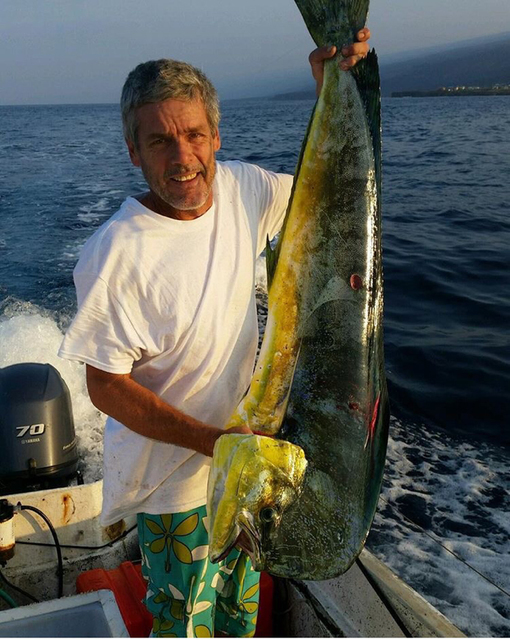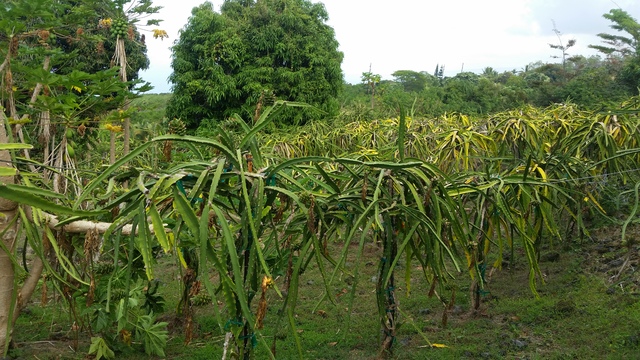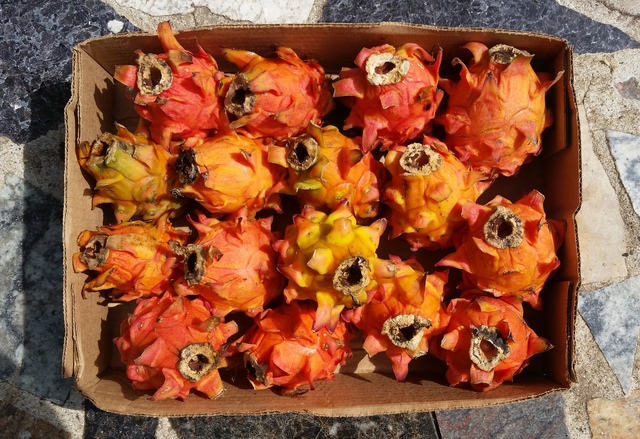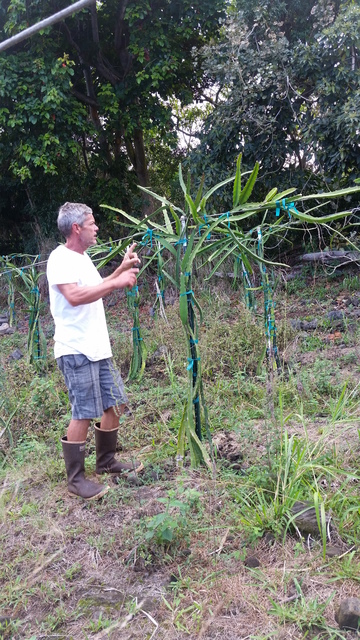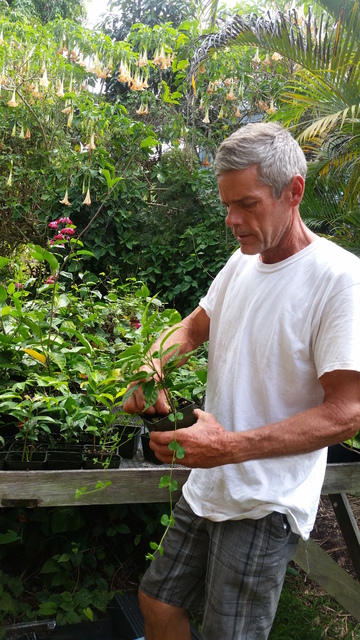Brad Hunter: Modern day hunter-gatherer
HONAUNAU — Is Brad Hunter a paleo man?
Well, almost.
Between 15,000 and 7,000 B.C., paleo people were migratory, following their food sources. They ate animals that they hunted or fished as well as nuts, berries and vegetables that they gathered. Not until the development of agriculture were people able to stay in one place without risking starvation.
Today, Brad hunts fish for animal protein and gathers seeds and cuttings to grow food on his farm. Though Brad does sell his excess produce, it is all fresh and unprocessed. He also gives a lot away or does exchanges for goods. Definitely, paleo style.
Preferring to work and raise a family in the milder climate of British Columbia, Brad’s father left the family farm in Saskatchewan before Brad was born. Brad remembers enjoying occasional visits to his grandparent’s farm until he was 12 and his family moved further away to Santa Barbara, California. Perhaps more than his grandfather’s farm, Brad’s career choices were influenced by his dad’s job as a salesman. Today, Brad is a successful fisherman and has a highly productive farm but what makes his dual interests really work for him is his ability to sell the products of his hunting and gathering.
Once Brad graduated from high school he began travelling, largely in Central and South America. Though his interest in surfing motivated his destinations, he was often captivated by the beautiful coffee farms he saw on his trips.
During these youthful travels, Brad visited a surfing friend in New Jersey. While there, he was offered a lucrative job with a commercial fishing fleet out of Barnegat Light, just north of Atlantic City. He stayed with the company for 10 years, doing longline fishing 200 miles off shore in the Gulf Stream.
On a stormy fishing outing in 1994, Brad happened to read an article in National Fisherman magazine about ika-shibi fishing in Hawaii.
The technique originated with Okinawan fishermen who changed their target from squid (ika) to tuna (shibi) after often losing the desired squid to feeding tuna. Two years later Brad moved to Kona and began a successful stint as a seamount fisherman, catching tuna near the underwater mountains off Hawaii. Working with seamount fisheries, he learned the modernized Hawaiian version called “drop stone” or “hand line” based on the ika-shibi technique but using different bait than squid. The similar Hawaiian “palu ahi” used banana leaves to wrap tasty chum bait of anchovies or sardines around a single or double hook often baited with opelo. The wrap was attached to a line and had a rock inside to carry the package into deep water. Once the line was fully extended, a jerk loosened the knot holding the package and it opened. At that point, the chum was released causing an ahi feeding frenzy and usually one of the feeding fish would bite the hook and be caught. Today, the wrap is cloth and the stone has been replaced with a fishing weight, but it remains a successful way to catch ahi tuna.
In 1998, Brad bought a coffee farm in south Kona and moved his young family onto the 5 acres where he still lives. At that point he was still working as a commercial fisherman, but wanted to try his hand at being a farmer.
“I had this completely romantic idea that coffee farming would be easy and fun, an idyllic lifestyle,” he said.
When reality set in, however, he realized that his coffee plants were not healthy and they were costing a lot of time and money to maintain.
“That was my first lesson in the necessity of adaptability to succeed at farming in Kona,” he said. “I had to find a better crop.”
After tasting some dragon fruit growing near the boat dock in Honaunau, he decided to try growing it on his farm. He took home seeds and cuttings of wild plants and was amazed to find that they grew and produced well at his location. At roughly 1,000 feet in elevation, just south of the rain belt, it was actually the perfect climate for dragon fruit. Wanting to be sure to select a reliable self-pollinating variety with a delicious flavor, Brad ordered nearly 100 seeds and cuttings of different varieties from southern California and grew them all out.
Two years later, when they fruited, he culled his plants down to a few of his favorite varieties. He found the yellow pitaya from Columbia among the sweetest but after trying a Peruvian cross between the yellow and a red dragon fruit, he chose that as his favorite. The Peruvian fruit is orange and has all the qualities he prefers, including a long season and great taste. Currently, he has almost 3 acres in dragon fruit production and most of his newer vines are the Peruvian orange. Though he eats a lot of the dragon fruit as well as his citrus, mangoes, avocados and lilikoi, he also sells his produce so he can buy groceries for his family. Today, his wife works as a nurse off the farm and his older children have moved away, but their early years together on the farm were definitely nourished by Brad’s efforts.
A few years into his farming adventure, Brad got his own boat and began fishing on his own. Today, he puts his boat in at Honaunau or South Point two or three days a week and rarely comes back empty-handed. He mostly trolls or uses the hand line technique to bring in ahi, mahi mahi, ono and more.
On Thursday and Friday afternoons Brad harvests from the farm and prepares his fish catch for market. The popularity of his fish and dragon fruit keeps a continuous line of customers moving at the Hunter Family Farm stand in the Keauhou Farmers Market on Saturday mornings.
“Selling at the market,” Brad said about what he enjoys most in his varied life. “Saturdays are my favorite day. After a week of pretty solitary farming and fishing, it’s great to talk to people about my fish and dragon fruit and give them a few avocados and limes. I love it.”
He often offers suggestions to his customers on starting dragon fruit. He also sells cuttings and is available for consultations on cultivating his favorite fruit.
In addition to reminding farmers to be adaptable, Brad also suggests following a very generous business model.
“If you give generously, it comes back. The universe provides. I’ve seen it work,” he said.
It certainly seems to be working for this modern day hunter-gatherer who is living comfortably by hunting fish and gathering plants that produce tasty food he can grow and sell.
Diana Duff is a plant adviser, educator and consultant living on an organic farm in Captain Cook.


